This is an authentic Polish potato and cheese pierogi (ruskie) recipe with mashed potatoes and twaróg - curd cheese. Soft, tangy and delicious, these dumplings are one of the most popular traditional Polish dishes. The post includes easy step-by-step instructions and photos.
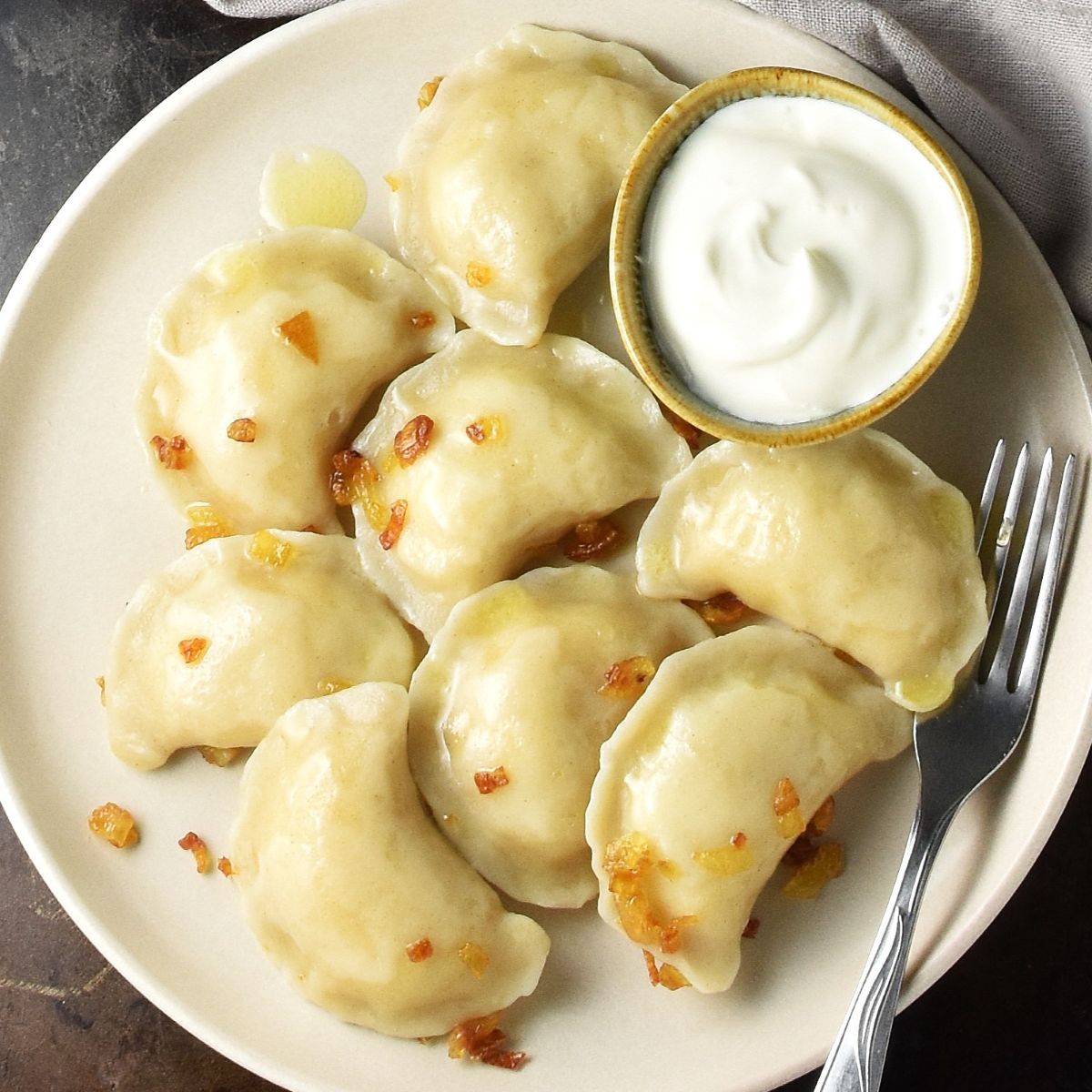
Polish potato and cheese pierogi are crescent shaped boiled dumplings consisting of thin, unleavened dough wrapped around a mashed potato curd cheese filling. Also known as 'pierogi ruskie' (pron. pye-ROH-ghy ROUS-kye) they are one of the most iconic traditional Polish dishes (which also include well-known barszcz soup and bigos). The name 'ruskie' comes from a region of pre-war Poland called Ruś (Red Ruthenia) which today is part of Ukraine.
Traditional Polish pierogi ruskie dough as well as the filling contain a handful of ingredients and involve a simple preparation method (this is true for all pierogi). They do require a bit of time but you can prepare the ingredients ahead and make the pierogi later (see my tips at the bottom of the post).
Although pierogi can have different fillings (such as sauerkraut, meat or blueberry) pierogi with potato and cheese are probably the most popular traditional dumplings in Poland. As a child I remember countless pierogi ruskie dinners served at home, at summer camps, celebrations (including Christmas) as well as in vegetarian eateries called 'bary mleczne' ('milk bars'). They were everywhere!
This recipe is a product of all of these experiences plus years of making my own pierogi dumplings. I hope you enjoy it:)
Potato and cheese pierogi ingredients and substitutions

The dough
- Potatoes: (see details below).
- Cheese: the traditional cheese used to make pierogi is twaróg, which is a type of curd cheese (see details below). Cottage cheese isn't a suitable alternative as it contains too much moisture. Dry curd cottage cheese may be a good substitute, although I haven't tried it (the ratio of cooked potatoes to cheese is roughly 2:1).
- Onion.
- Oil and butter: I like to use butter for flavour and oil to prevent the onion from browning too much.
- Salt and pepper.
The filling
- All-purpose/plain flour.
- Water: it's important to use hot water (this will help produce a soft dough).
- Oil: you can use butter, instead.
- Salt.
What cheese to use
Twaróg cheese, also called 'twaróg wiejski' (which means 'country-style') and 'ser biały' (meaning 'white cheese') is an essential ingredient in classic Polish cuisine and the star ingredient of pierogi ruskie (as well as Polish crepes, cheesecake and sweet cheese pierogi). Twaróg gives these traditional Polish pierogi dumplings their unique, sour flavour.
Polish 'white cheese' tastes similar to cottage cheese, but has a firmer texture, a bit like feta but softer. It comes in 3 versions: full-fat ('tłusty'), reduced-fat ('pół-tłusty') and fat-free ('chudy'). I've made pierogi with all of these types of twaróg and they all tasted similar. However, both the full-fat and reduced-fat varieties produced a creamier texture. So use whichever you prefer (even if you use the full fat cheese your pierogi will still be low in fat).
The North-American version of Polish potato cheese pierogi (often spelled 'pierogies' or 'perogies') is made with cheddar instead of twaróg (which can be hard to come by outside of Poland).
What potatoes to use
Polish pierogi with potato-and-cheese filling should be made with higher starch/floury potatoes (good for mashing) or all-rounders. These can be Russets, Yukon Golds (or Maris Piper/Kind Edwards if in the UK).
How to make pierogi ruskie: step-by-step instructions
Make filling
1. Prepare potatoes: Peel and halve or quarter the potatoes then boil in salted water until tender. Drain thoroughly then mash until creamy. Set aside to cool.
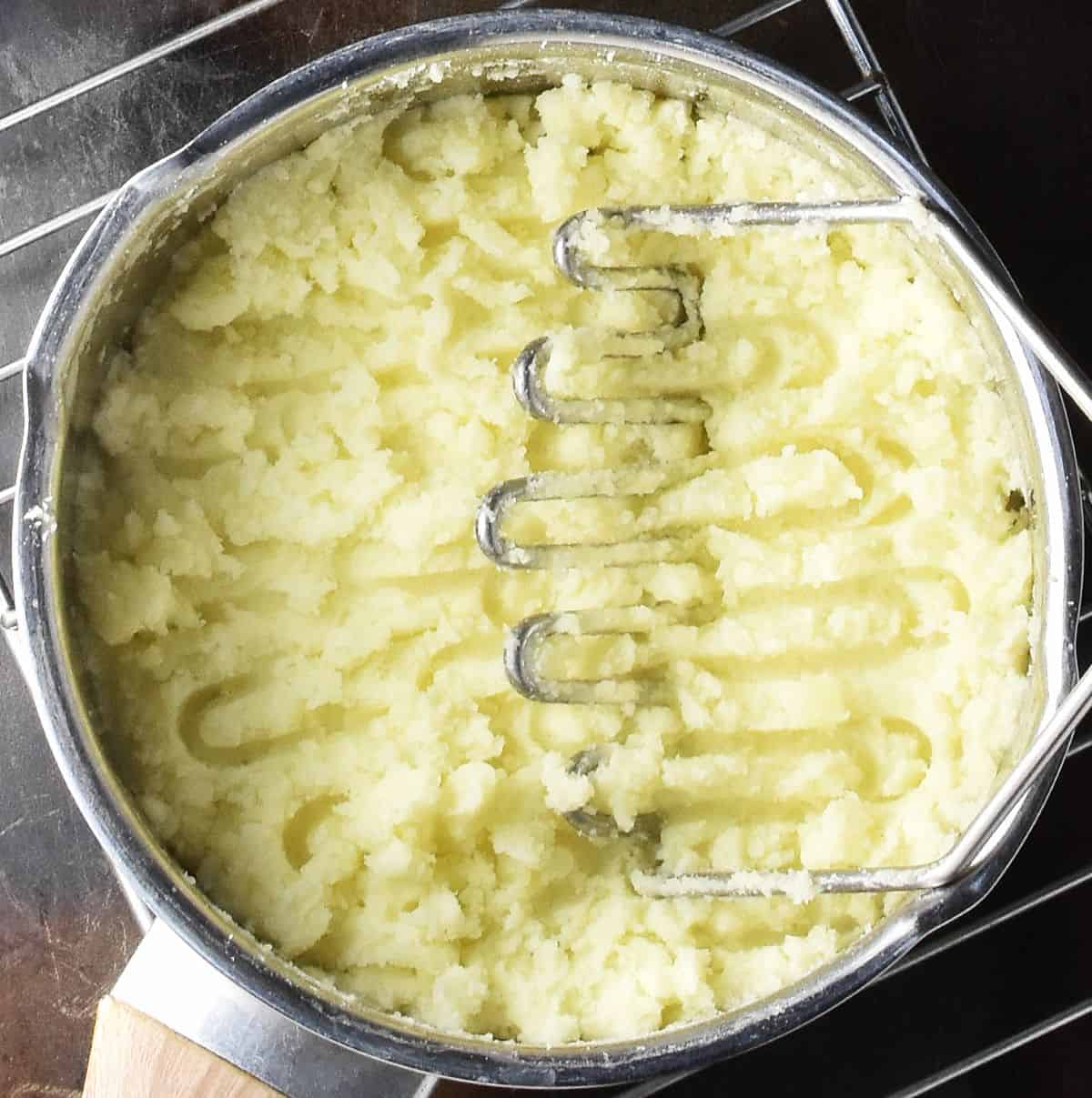
2. Prepare onion: To a pan add the oil and butter and fry the onion gently for a few minutes until softened and translucent (do not brown it). Add to the potato.

3. Add cheese: Add the cheese, salt and a generous amount of pepper then using a potato masher incorporate into the mixture. Taste and adjust the seasoning if required. Set aside while you make the dough.
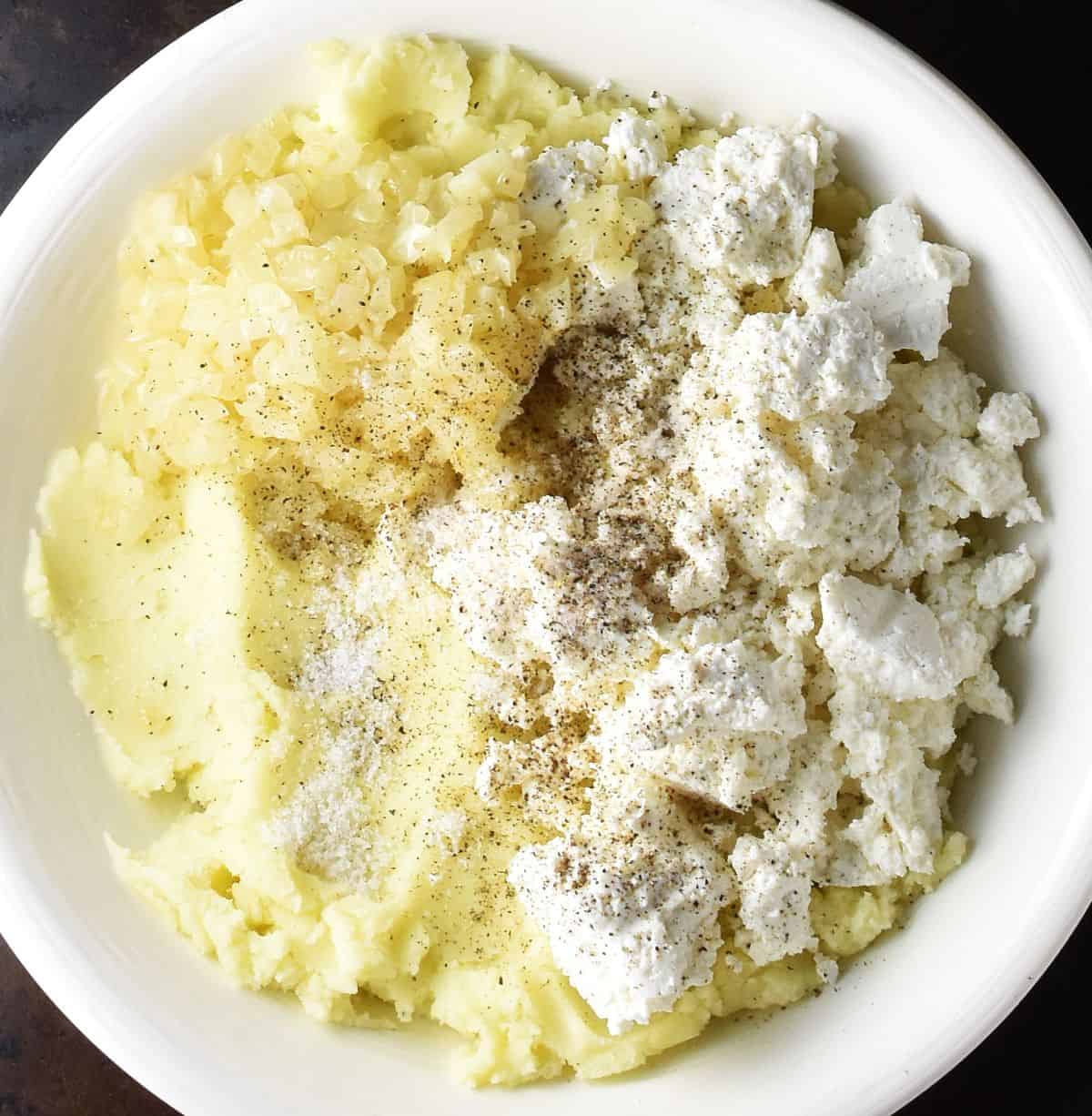

4. Prepare filling balls: Make round pierogi filling balls the size of small walnuts (weighing approx. 18 grams each). Refrigerate the balls while you make the dough.
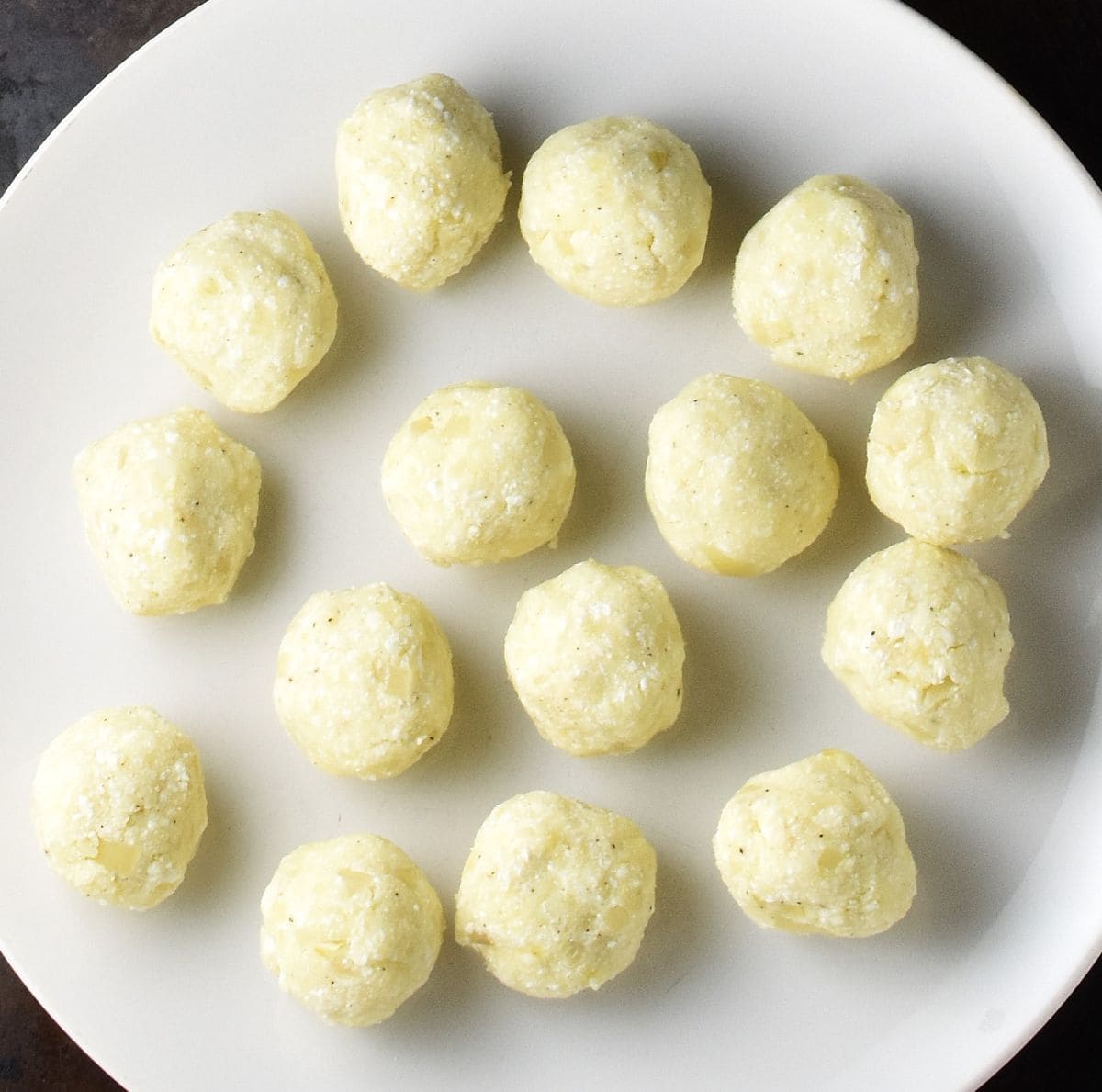
Make dough
5. Prepare dough: To a large bowl add the flour, salt and oil then gradually add the hot water stirring in with a spatula or spoon. Knead briefly to form a rough dough then place it on a clean surface and knead for 6-8 minutes until silky smooth and soft. Cover the dough loosely with cling film (to prevent it becoming dry) and set aside on a lightly flour surface for 30 minutes (longer is fine).
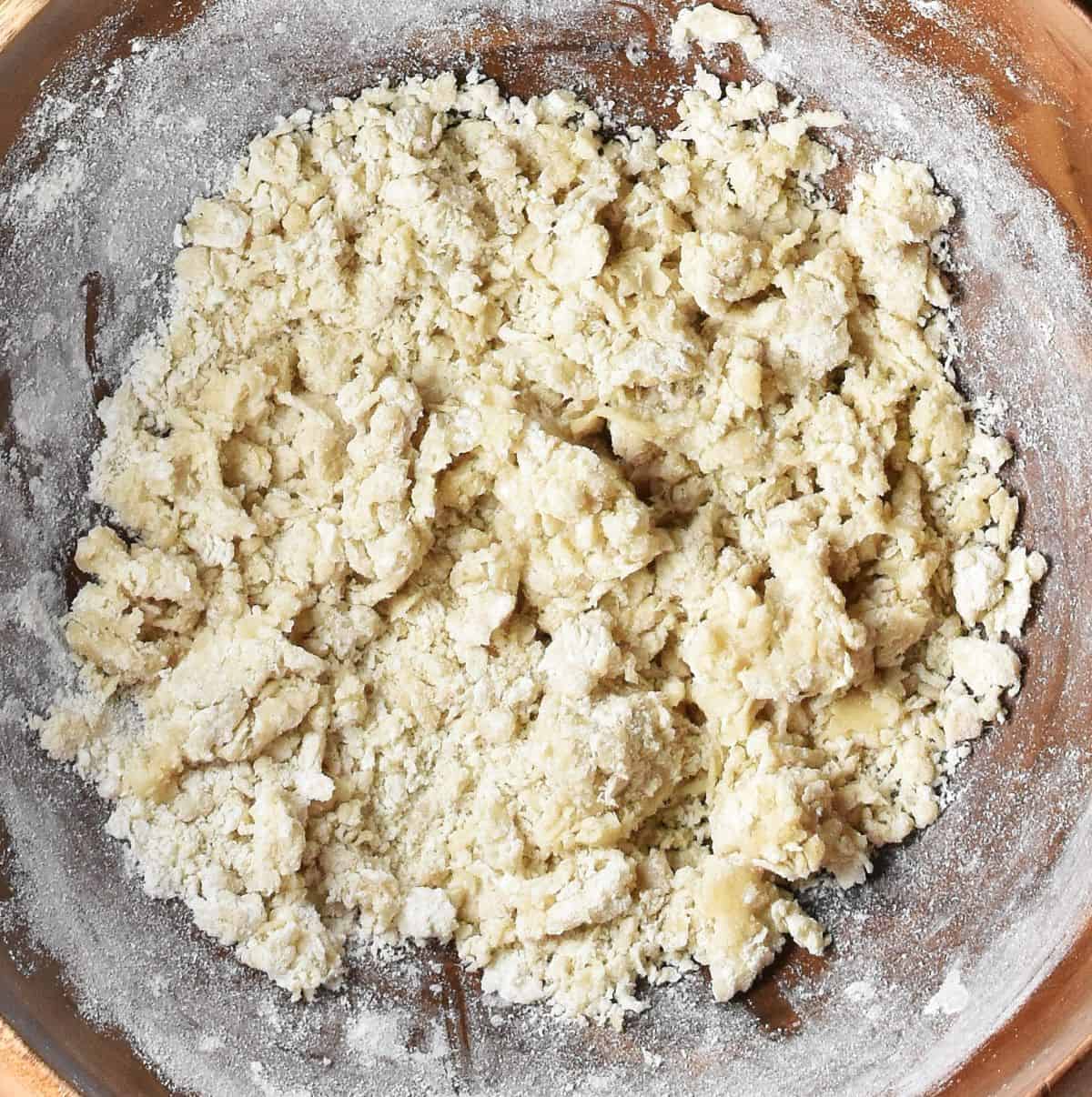

6. Roll out dough: Divide the dough into 3 parts (easier to work with). Roll out one part (keeping the others covered) on top of a lightly floured surface to a thickness of about 2mm (quite thin). If the dough becomes sticky as you roll sprinkle with a little flour and spread over the surface using the palm of your hand then turn it over (you can do this 2-3 times) and continue rolling.
- TIP: Add only as much flour as is necessary (to avoid tough, chewy pierogi). Also at this point start heating a large pot of water (add about 1.5 teaspoons of salt).
Assemble and cook
7. Form pierogi: Using a cookie cutter (or the rim of a glass) with a diameter of about 6.5-7cm (2.8-3'') cut out round shapes. (Gather up the dough scraps and add to the remaining dough). Place the dough round in the palm of your hand (if the dough sticks to your work surface use a thin spatula to gently help it come away). Place the filling ball in the centre, flatten, bring the sides together then using your fingertips stick the edges together (gently pushing the filling into the dumpling away from the edges). Go over the edges twice (but try not to make them too big).
- TIPS: I find it helpful to keep a paper towel handy to wipe my fingertips in case the filling mixture sticks to them. Keep the pierogi on top of a floured surface and cover with a kitchen cloth to prevent drying. Boil each batch (10-12 pierogi) as soon as you've made it.
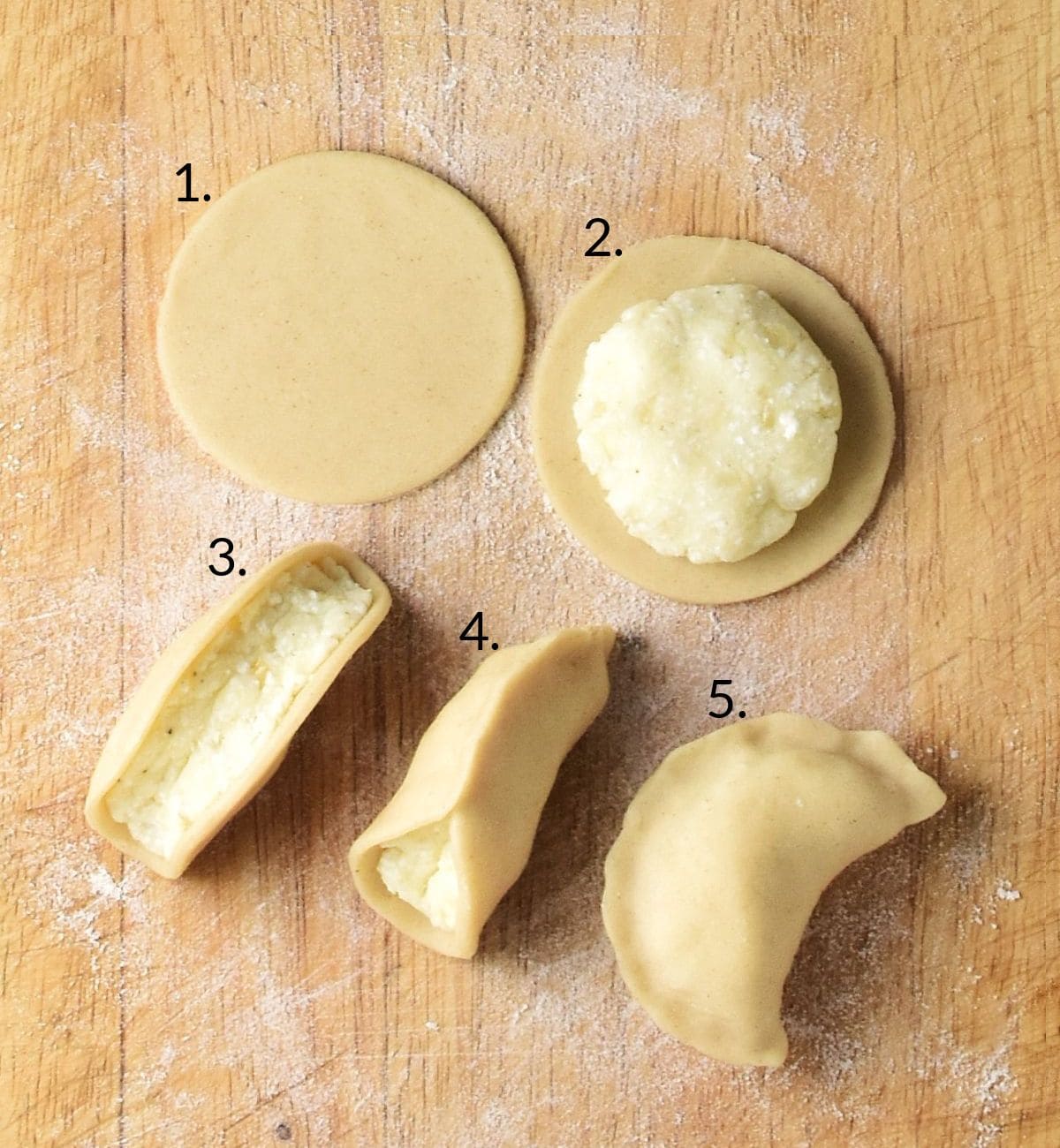
8. Boil pierogi: When the water starts to boil carefully add the pierogi, one by one (but don't lower the heat yet) and immediately stir gently with a wooden spoon to prevent them sticking to the bottom of the pot and each other. When the water starts to boil too rapidly lower the heat. When all the pierogi have come up to the top simmer gently for 4 minutes. Stir once or twice throughout cooking (or as needed).
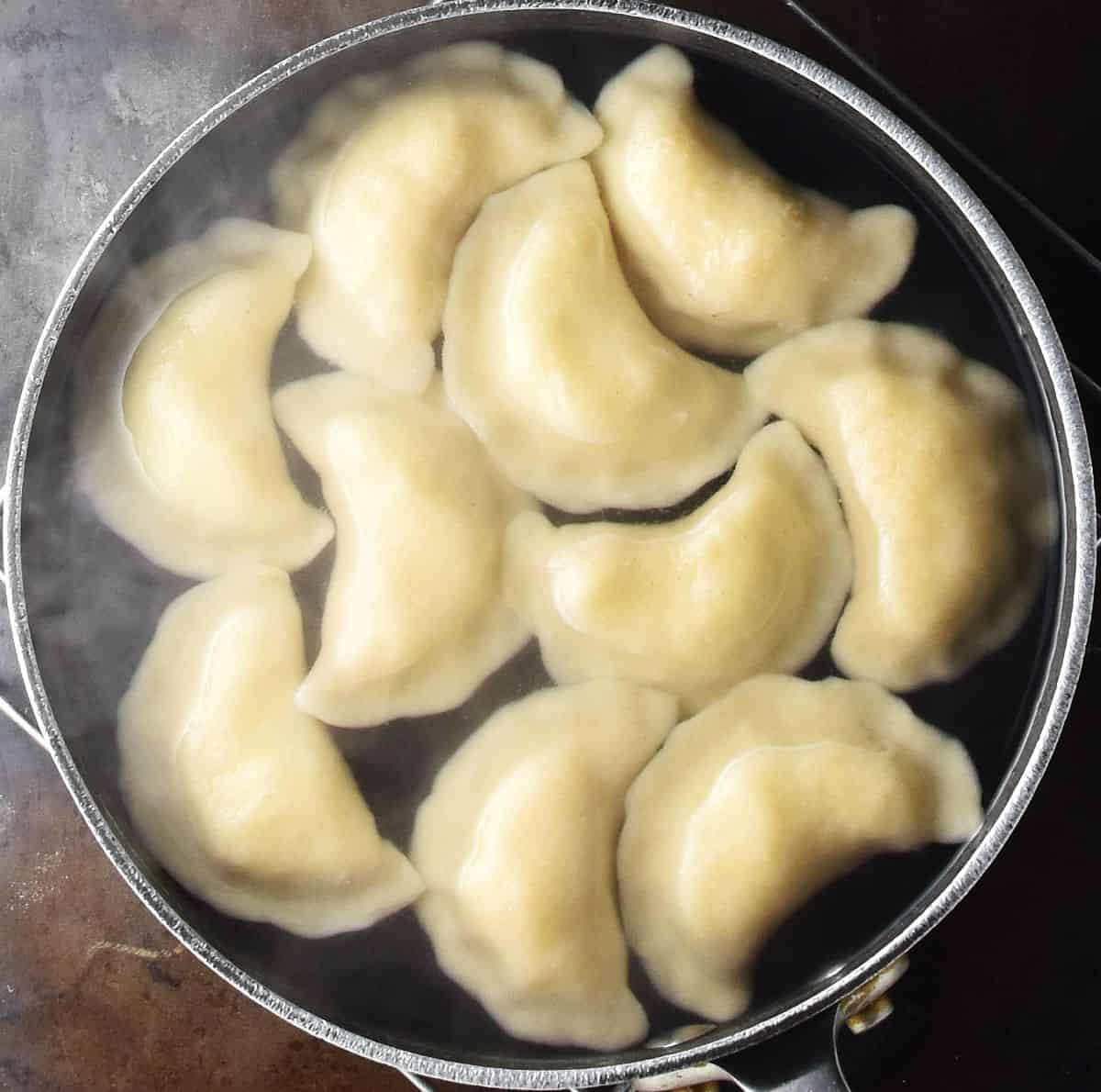
9. Serve: Lift the pierogi out of the pot using a slotted spoon (getting rid of as much water as possible) and place in a single layer on top of a greased plate. Drizzle with a little melted butter and serve.
- TIP: Alternatively keep the pierogi covered while you make the next batch. Use the same water topping up if necessary. I keep my pot of water covered, simmering, so I can boil each batch as soon as I've made it.

Serving suggestions
In Poland potato and twaróg cheese pierogi are served as a main dish, often preceded by one of many traditional soups. Pierogi can be eaten hot simply drizzled with a little butter and a dollop of sour cream. They can also be served with:
- Sauteed onion: pan fry 1 finely chopped large onion on a low heat with 1 tablespoon of oil and butter, each, for 10-15 minutes until lightly browned and crispy (be careful not to brown it too much). Do this in advance and simply reheat when you are ready to serve the pierogi (see photo below).
- Crispy bacon: finely chop the bacon and pan fry over a medium heat until crispy stirring often (in Poland lard is often used in place of bacon). Transfer to a bowl then reheat and serve over hot pierogi.
You can also pan fry these vegetarian pierogi ruskie before serving. I recommend placing them on top of a plate for a couple of minutes first (as in Step 9) to get rid of extra moisture. Then pan fry with a little oil and butter (you don't need to use too much especially if using non-stick pan) for a few minutes until lightly browned and crispy on both sides. Serve with sour cream, sauteed onion or crispy bacon (as above).

Make ahead
- Potato-cheese pierogi filling: this mixture can be refrigerated (covered) for up to 2 days.
- Dough: make the dough, cover with a kitchen cloth and set aside for a few minutes until it cools completely (if still a little warm). Next wrap in cling film and refrigerate overnight. Bring up to room temperature before making pierogi.
Make now - eat later
If you are planning to serve these Polish pierogi dumplings at a potluck dinner or as a meal later place them in a large bowl or casserole dish (making sure they are lightly coated in oil or butter so they don't stick to one another). You can also add sauteed onions or bacon into the dish. Allow to cool completely then cover and refrigerate.
When you are ready to serve your pierogi you can either reheat them, covered, in a preheated oven (180-190C) or in the microwave (if it's a small batch). I often use these methods at Polish Wigilia - Christmas Eve meal.
Freezing, thawing and cooking
- Uncooked Polish potato-cheese pierogi: arrange in a single layer on top of a floured tray and freeze for 2 hours. Next transfer to a freezer bag/airtight container and freeze for up to 3 months. Cook from frozen. Bring the water to the boil, add the pierogi and boil as per Instructions (Step 8). When they come up to the top simmer for 5-6 minutes.
- Cooked pierogi: cool them completely first then arrange individual portions in small trays (brush the pierogi thoroughly with a little oil beforehand), cover with plastic wrap and freeze for up to 3 months. Defrost in the fridge overnight. Reheat in a microwave or pan fry.
Top tips summary
- Use Polish 'twaróg' cheese, which you can buy in a Polish store (or some large supermarkets, if in UK).
- I recommend using higher starch/floury potatoes (good for mashing), such as Russets, Yukon Golds (or Maris Piper/King Edwards if in UK).
- Roll out the dough in batches (easier to work with) to a thickness of about 2mm (this is quite thin).
- To save time you can make the dough while you are waiting for the potatoes to boil and cool.
- Taste the filling mixture and adjust the seasoning if required before making the pierogi. Some of the flavour will be absorbed by the dough so make sure the filling is well seasoned.
- Keep the dough covered with cling film (loosely at first as it might still be warm).
- It's important to bring the water to the boil before cooking the pierogi.
- Keep uncooked pierogi on top of a floured surface and cover with a kitchen cloth as they dry out quickly. This is also why you should boil them as soon as you've made a batch (10-12).
- Store leftover cheese and potato pierogi in a container or bowl, covered, and refrigerate for up to 4 days.
Related recipes to try next
See also these other authentic Polish recipes!
Recipe
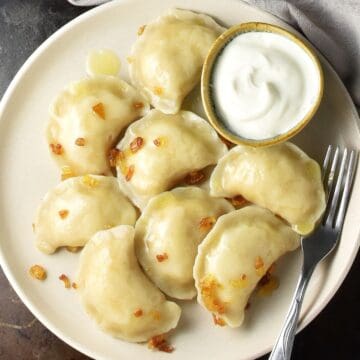
Potato and Cheese Pierogi Ruskie - Authentic Polish Recipe
Equipment
- Large pot
- Rolling Pin
- Slotted Spoon
- Potato masher
- Cookie cutter or glass diameter 7cm/3"
Ingredients
For the Filling
- 8.82 ounces (250 g) Polish twarog cheese see *Notes
- 1½ pounds (680 g) potatoes unpeeled, see **Notes
- 1 medium onion finely chopped
- 1 tablespoon vegetable oil
- 2 teaspoons butter
- 1 teaspoon fine sea salt plus lots of freshly ground pepper
For the Dough
- 2¾ cups (345 g) all-purpose/plain flour
- ¾ cup (180 ml) hot water
- 2 tablespoons (30 ml) vegetable oil or butter
- ½ teaspoon fine sea salt
Instructions
Make Filling
- Prepare potatoes: Peel and halve or quarter the potatoes then boil in salted water until tender. Drain thoroughly then mash until creamy. Set aside to cool.
- Prepare onion: To a pan add the oil and butter and fry the onion gently for a few minutes until softened and translucent (do not brown it). Add to the potato.
- Add cheese: Add the cheese, salt and a generous amount of pepper then using a potato masher incorporate into the mixture. Taste and adjust the seasoning if required. Set aside while you make the dough.
- Prepare filling balls: Make round pierogi filling balls the size of small walnuts (weighing approx. 18 grams each). Refrigerate the balls while you make the dough.
Make dough
- Prepare dough: To a large bowl add the flour, salt and oil then gradually add the hot water stirring in with a spatula or spoon. Knead briefly to form a rough dough then place it on a clean surface and knead for 6-8 minutes until silky smooth and soft. Cover the dough loosely with cling film (to prevent it becoming dry) and set aside on a lightly flour surface for 30 minutes (longer is fine).
- Roll out: Divide the dough into 3 parts (easier to work with). Roll out one part (keeping the others covered) on top of a lightly floured surface to a thickness of about 2mm (quite thin). If the dough becomes sticky as you roll sprinkle with a little flour and spread over the surface using the palm of your hand then turn it over (you can do this 2-3 times) and continue rolling.TIP: Add only as much flour as is necessary (to avoid tough, chewy pierogi). Also at this point start heating a large pot of water (add about 1.5 teaspoons of salt).
Assemble and cook
- Form pierogi: Using a cookie cutter (or the rim of a glass) with a diameter of about 6.5-7cm (2.8-3'') cut out round shapes. (Gather up the dough scraps and add to the remaining dough). Place the dough round in the palm of your hand (if the dough sticks to your work surface use a thin spatula to gently help it come away). Place the filling ball in the centre, flatten, bring the sides together then using your fingertips stick the edges together (gently pushing the filling into the dumpling away from the edges). Go over the edges twice (but try not to make them too big).TIPS: I find it helpful to keep a paper towel handy to wipe my fingertips in case the filling mixture sticks to them. Keep the pierogi on top of a floured surface and cover with a kitchen cloth to prevent drying. Boil each batch (10-12 pierogi) as soon as you've made it.
- Boil pierogi: When the water starts to boil carefully add the pierogi, one by one (but don't lower the heat yet) and immediately stir gently with a wooden spoon to prevent them sticking to the bottom of the pot and each other. When the water starts to boil too rapidly lower the heat. When all the pierogi have come up to the top simmer gently for 4 minutes. Stir once or twice throughout cooking (or as needed).
- Serve: Lift the pierogi out of the pot using a slotted spoon (getting rid of as much water as possible) and place in a single layer on top of a greased plate. Drizzle with a little melted butter and serve.TIP: Alternatively keep the pierogi covered while you make the next batch. Use the same water topping up if necessary. I keep my pot of water covered, simmering, so I can boil each batch as soon as I've made it.
Notes
- *Use Polish 'twaróg' cheese, which you can buy in a Polish store (or some large supermarkets, if in UK).
- **I recommend using higher starch, floury potatoes (good for mashing) or all-rounders, such as Russets, Yukon Golds (or Maris Piper/King Edwards if in UK).
- Roll out the dough in batches (easier to work with) to a thickness of about 2mm (this is quite thin).
- To save time you can make the dough while you are waiting for the potatoes to boil and cool.
- Taste the filling mixture and adjust the seasoning if required before making the pierogi. Some of the flavour will be absorbed by the dough so make sure the filling is well seasoned.
- Keep the dough covered with cling film (loosely at first as it might still be warm).
- It's important to bring the water to the boil before cooking the pierogi.
- Keep uncooked pierogi on top of a floured surface and cover with a kitchen cloth as they dry out quickly. This is also why you should boil them as soon as you've made a batch (10-12).
- Store leftover cheese and potato pierogi in a container or bowl, covered, and refrigerate for up to 4 days.
- See serving suggestions and freezing instructions in the post.
Nutrition
*Nutritional information is automatically generated and should be considered as an estimate.
**A note about baking: If using a fan-assisted oven refer to your appliance's instructions and adjust the temperature accordingly.
Keep in touch!
Have you made these Polish potato and cheese pierogi? How did they turn out for you? Let me know in the comments below, thanks!
Follow me on Facebook, Instagram and Twitter for regular recipe updates! Or you could subscribe to this blog and receive all my latest recipes right into your mailbox!

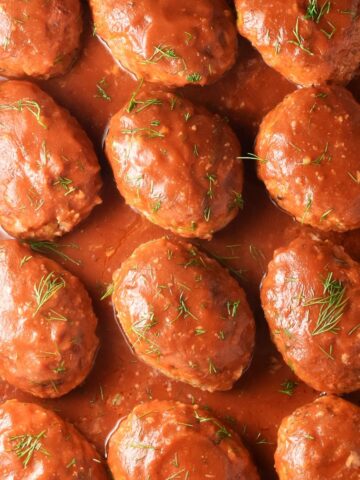


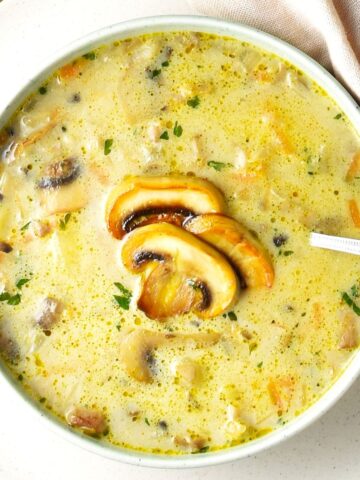
Anna ingrassia says
i do believe that another good substitute cheese would be 'queso blanco' a dry cheese like feta... not as salty, and used by Sephardic Jews. It would most likely be closer to twarog than feta but IDK for sure. I am sure it CAN be used, tho. Shalom
Monika says
Thank you for your feedback:) Since twarog is often called 'white cheese' in Poland it is probably quite similar to 'queso blanco' which also means 'white cheese'. I understand that there are many varieties of this cheese whereas there is only one twarog.
Anna Air says
I followed the recipe but quite a few fell apart when put in the salted boiling water. I found the dough very soft, I think I could have rolled the dough too thin that is probably why they burst. I still fried them in butter and they were good. I also made sauerkraut ones too. Can you tell me why in some receipts you add a egg?? I will have to make them again in the next few days. I love to try different ways with receipts.
Monika says
Hi Anna. The dough should be soft and as long as it doesn't stick to your hands it's fine (if it does add a small amount of flour). It sounds like there was a problem with forming the actual pierogi - make sure you stick the edges together really well. Also it's a good idea to wipe your fingertips as you are making the pierogi to ensure they are dry (not sticky or covered with flour). Hope this helps:)
The only pierogi recipe where I use an egg to make the dough is the cheddar potato ones and this is to make them richer (they are not traditional Polish pierogi). If you prefer that dough you can use it with this pierogi filling.
Darren says
I found these dumplings ready made recently in the UK in Asda. Was a bit disappointed though as they were advertised as "vegetarian" but when we got them home we noticed on the ingredients that the onions contained "pork fat" - no idea why pork fat as there was already sunflower oil in the onion ingredients too! I made an exception as we'd already bought them at that stage and it was either eat them and ignore the pork fat or throw them away which would have been a waste of an animals life.
They were nice and had they not used pork fat in them I would certainly have got them again, but glad to have found this recipe though that doesn't contain pork fat in the ingredients. I might give it a go and actually make this version.
Monika says
Hi Darren, I am surprised about the pork fat as well, I am guessing it was added into the onion mixture (especially if they were coated in fried onions). If you liked these ready made pierogi I guarantee you'll love the homemade variety. Do let me know how they turn out if you decide to make them. Thanks very much for the feedback:)
Barb says
I grew up making pierogi with my family. We used potato, sauerkraut, bacon and onion mixed together for the filling. So yummy. I’m going to make some next weekend.
Monika says
Sounds like a delicious filling mixture for pierogi!
cecile says
can you make the filling a day in advance? Or the morning of?
Monika says
Yes you can to both. Keep it in the fridge.
liz Wawrzyniak says
The butter for the dough should it be at room temperature.?
Monika says
It doesn't really matter as you'll be adding hot water so the butter should get easily mixed in with the rest of the ingredients. And that's the main thing.
Helen Kennedy says
My family are Polish and my mother used to make pierogi frequently. In the 1960s you definitely couldn't get twarog, I hadn't even heard the name until recently, so she used crumbly cheese such as Caerphilly, Lancashire and Wensleydale. Naturally, we had them for Wigilia.
Monika says
Honestly pierogi are delicious with any cheese, and I can imagine they would be great with any of these cheeses as they have so much flavour. I actually make them with cheddar sometimes too (the recipe is on the blog).
Mila says
That's interesting too 😀 I think nowadays tvorog is sold almost everywhere. Yours is not salted or sweet, right?
I guess Polish tvorog tastes absolutely the same as in my home country- Russia..? But if we use tvorog in these dumplings, they are sweet; and if with potatoes - not sweet 🙂 but never together. Actually, I can't imagine what will be the taste, hope one day I will try Polish version 🙂
Monika says
That's interesting, so twarog in Russia is always sweet? You could make these pierogi using just sweet twarog as well (the recipe is on the blog). But this recipe is savoury, twarog and potatoes together are amazing! Sposiba:)
Mila says
Hi Monika. Nooo, twarog is not sweet, I meant that when we cook these dumpling with tvorog, we adding sugar, so dumplings with tvorog are usually sweet. But of course, you can add salt-pepper and some herb to twarog and eat it savory. 🙂
Monika says
Oh, I see, so Russian twarog is probably very similar to Polish. Thanks for clarifying this!
Mary Barr says
Pierogi scene to be made a little different by each family it depends on your family just like in the dough I use buttermilk naked very nice tender dough and then the feeling I have used cream cheese cottage cheese I live out in the country if I feel like making pierogi and I have what I have that's what I use so that's what pierogies are anyway my family's two favorites are to sauerkraut and the potato and all my kids grandkids and great-grandkids love them and I just don't make them once a year every time I turn around I'm making pierogi
Monika says
Thank you for taking the time to share this, Mary! It's true that pierogi can be made in so many ways, using different ingredients. I've never tried adding cream cheese into the filling, sounds interesting!
Monika says
Thank you Kat! They are pretty moreish so it's not difficult to eat a little too many:)
Monika says
Thanks Midge, my kids wouldn't forgive me if I didn't make these every year and as much as they love Chinese dumplings too they'd definitely prefer the cheese ones (for Christmas Eve at least)
Monika says
Thank you, kids love this kind of food (mine could eat it every day!)
Monika says
Thank you, always happy to join in with Fiesta Friday:)
Cat says
These look delicious. I have seen pierogi a lot on to programmes but have never actually tried them. My parents went to Poland a few years ago so I told them they have to try them and they loved them. I'll have to give this recipe a go - thanks x
Monika says
I hope you like them if you do make them:)
Mollie says
Oh Monika, I'm just blown away by this recipe!! Love it!!
Monika says
Thank you! It's really a simple one, though does take a bit of time to come together.
Mollie says
I can see it's a bit of work, but the end results...my goodness does it look good!
Monika says
Thank you:)